BESG presented a paper “Citizen science and the monitoring of hornbills in Singapore” at the 5th International Hornbill Conference in Singapore on March 2009 LINK. The proceedings, published by the Raffles Museum of Biodiversity of Research, National University of Singapore (left), can be accessed at this LINK where papers can be downloaded.
This post summarises what local citizen scientists contributed to hornbill behaviour up to March 2009 as detailed in the paper as well as contributions beyond that date.
Early sightings:
Sightings on hornbills have been reported as early as the 19th century. However, details of their behaviour were only documented during the early 2000s when digital photographers and the BESG entered the local birdwatching scene. There was a Bird Group affiliated to the then Malayan Nature Society (Singapore Branch) as early as 1984, but unfortunately citizen science broke down when locals took over the leadership of the group (Wee & Subaraj, 2009). And according to the author: “Deprived of experienced leaders and the exit of many expatriate birdwatchers, locals took the easy way out and simply watched birds.”
Hornbills always cause great excitement whenever they are encountered in urban Singapore. Thus the early contributions by this new breed of citizen scientists were, understandably, simple sightings. As far back as March 2006, Angie Ng, Marisa Keller, Fuhai Heng, Goh Si Guim, James Heng, Angelia and Johnny Wee reported sightings of the Oriental Pied Hornbill (Anthracoceros albirostris) at various locations in Singapore LINK. In the same month, the late Stephen Lau reported a Great Hornbill (Buceros bicornis) visiting his apartment LINK; Ong Hui Guan photographed a Great Hornbill in the dairy Farm Estate in Bukit Timah; while Kwek Siew Jin saw a Rhinoceros Hornbill (B. rhinoceros) while walking in the Bukit Timah Nature Reserve LINK.
Behaviour documentation:
Subsequent contributions were on the food the Oriental Pied Hornbill. Animal food include a bee (Dr Yeo Seng Beng) LINK; insects (KM Sim) LINK; caterpillar (KC Tsang) LINK; grasshopper (Abiel Neo) LINK; spider (Dr Tan Heok Hui) LINK; and crabs (Johnny Wee) LINK. Plant food include rambutan (Nephelium lappaceum) (Marcus Ng); LINK; papaya (Carica papaya) (Tan Teo Seng) LINK; Leucaena and Moringa seeds (Tan Teo Seng) LINK; palm fruits (Johnny Wee) LINK; and sea grapes (Coccoloba uvifera) (Ria Tan) LINK.
In May 2010 Kwong Wai Chong documented the comfort behaviour of an oriental Pied Hornbill LINK while in April 2011 he photographed signs of moulting in another bird LINK.
Courtship rituals were reported by Kennie Pan in March 2010 LINK and by Kwong Wai Chong in Feb 2011 LINK. In the same month Lim Poh Bee reported some strange behaviour by a Great Hornbill in nearby Malaysian state of Trengganu LINK.
Courtship between a female Great and a female Rhinoceros Hornbill:
In May 2006, there was great excitement when a female Great and a female Rhinoceros Hornbill were sighted in the Eng Neo area LINK. Located by bird photographers, Ng Bee Choo alerted birdwatchers who were generally uninterested in the event, most probably because these birds were escapees. It was left to photographers to document the courtship rituals, with Yoke Meng and Melinda Chan taking the lead LINK. The detailed observations of this unique courtship by two females of different species were subsequently published in scientific journals (Chan et al., 2008; Wee & Subaraj, 2006). Subsequently Brian Ng located the roost of the Great Hornbill to a large rain tree (Samanea saman) by his condominium at Adam Road LINK.
Courtship and breeding in Changi:
In November 2006 interests in hornbills shifted to Changi Village where a few pairs were sighted indulging in courtship. S. Subaraj as well as Yoke Meng and Melinda Chan documented the conflict between the Oriental Pied Hornbill and two species of parrots over the use of a nesting hole in a tree LINK.
At different times, courtship rituals and nesting by a pair of Oriental Pied Hornbills were documented, by Meng and Melinda Chan LINK; Angie Ng LINK; Emily Kang and Leck LINK; Angie Ng, Yoke Meng and Melinda Chan, KC Tsang and Allan Teo LINK; and YC and Melinda Chan LINK.
A breeding in June 2009 saw the cooperation between Dr Jeff Lim and Howard Banwell when they joined forces to make observations in Changi that resulted in a paper, Banwell & Lim, 2009 LINK.
Hornbills in Pulau Ubin:
The population of the Oriental Pied Hornbill in Changi Village is believed to have come from the nearby offshore island of Pulau Ubin. A population was first observed there by birdwatchers from the NSS’s Bird Group as early as the 1990s, but details of breeding were never recorded. It was again left to photographers to document the breeding of these hornbills in Pulau Ubin a decade later. In February 2007 Dr Jonathan WK Cheak photographed a breeding pair LINK, followed by Dr Eric Tan who photographed the female breaking out of nest when the chicks were ready to fledge LINK. Other observations included one by Ali Ibrahim LINK and Angie Ng LINK.
Escapee hornbills:
In 2008 a Narcondam Hornbill (Rhyticeros narcondami) was sighted at Bidadari Cemetery by KC Tsang and Ben Lee LINK; and a Southern Ground Hornbill (B. leadbeateri) was sighted by Steven Chong and Chan Kok Wai at West Coast Park LINK.
The future of Citizen Science:
Lena Chow’s video clips of a hornbill foraging like a woodpecker LINK is an indication of the future trend for citizen scientists. Binocular observations have long been eclipsed by photographic documentation as permanent images have proved useful should reinterpretation become necessary regarding identifications, etc. Obviously the future lies in videography as video clips allow for detailed examination of behavioural patterns in the comfort of the home.
YC Wee
Singapore
July 2011
References:
1. Banwell, H. M. & J. C. W. Lim, 2009. Observations on a successful nesting of a pair of Oriental pied hornbills (Anthracoceros albirostris, Shaw & Nodd, 1790) at Changi Village, Singapore. Nature in Singapore 2: 275-281.
2. Chan, Y. M., Chan, M. & Wee, Y. C. (2008). Aberrant behaviour of a female Great Hornbill and a female Rhinoceros Hornbill. Nature in Singapore 1:31-34.
3. Wee, Y. C., 2011. Citizen science and the monitoring of hornbills in Singapore. The Raffles Bulletin of Zoology. Supplement 24: 23-25.
4. Wee, Y. C. & R. Subaraj, 2006. Aberrant behaviour of a pair of female Great and Rhinoceros Hornbills in Singapore. Birding Asia 6:18-22.
5. Wee, Y. C. & R. Subaraj, 2009. Citizen science and the gathering of ornithological data in Singapore. Nature in Singapore 2: 27-30.
Acknowledgements:
BESG thanks all contributors for their generosity in sharing sightings, observations and images. The above may not be a comprehensive review of all contributors – our apologies for missing out a few. Image of proceeding courtesy of RMBR-NUS and miniature images are from earlier contributors.


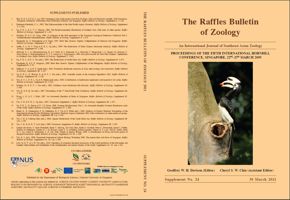
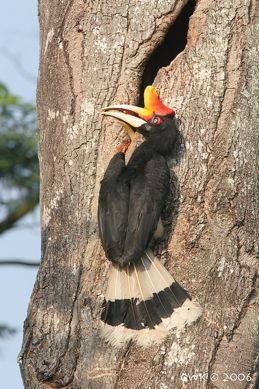
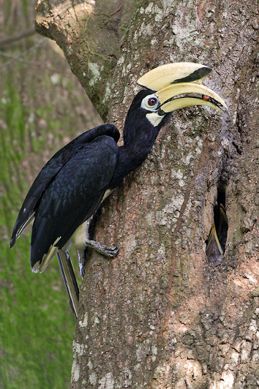
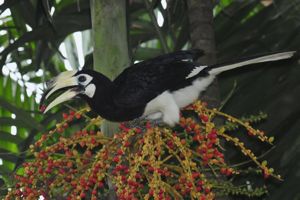

![HornbillG behav [LimPohBee] - 4](https://besgroup.org/wp-content/uploads/HornbillG-behav-LimPohBee-4.jpg)

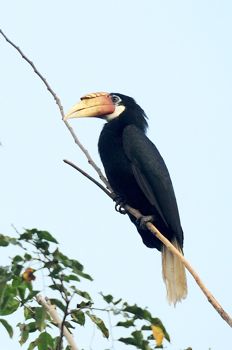
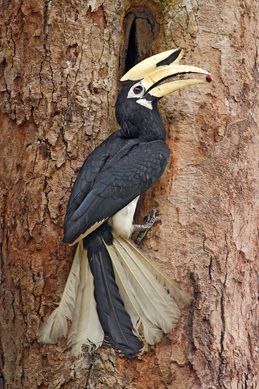
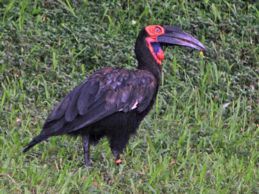







2 Responses
Hi there, I should’ve sent this in much earlier (though I’ve never had the time to) but I’ve once observed an Oriental Pied Hornbill catching, then eating a tree-climbing crab (Episesarma sp.) at Chek Jawa by ‘hovering’ in mid-air and grabbing the crab as it was climbing up a tree. You can view the pictures I took at this link here: https://picasaweb.google.com/david.planeswalker02/PulauUbinOn1July2010?authuser=0&feat=directlink
Thanks David.